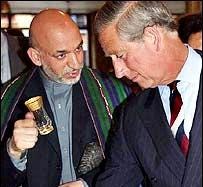Whatever happened to King Charles III's passion project in Afghanistan?
My conversations with Rory and Shoshana Stewart, who helped Charles create cultural, educational, and business enterprises with the Turquoise Mountain Foundation
In September 2021 I was invited by Dame Karen Pierce, the British ambassador to the United States, to a reception for Shoshana Stewart, the chief executive of the Turquoise Mountain Foundation. The foundation had been created by Prince Charles in 2006 to restore the historic Old City of Kabul in Afghanistan and support the country’s indigenous arts and crafts. The gathering in Washington’s Embassy Row occurred only weeks after the forcible takeover of Afghanistan by the Taliban. The autocratic Muslim fundamentalists had seized power during the chaotic final withdrawal of United States forces after nearly two decades of war following the 9/11 bombings in 2001 that killed 2,996 people in the World Trade Center in lower Manhattan, the Pentagon, and a plane crash site in Pennsylvania. As Afghanistan’s rulers in 2001, the Taliban had provided a safe haven for the Al Qaeda terrorists to mastermind the unprecedented attacks.
My special interest in Turquoise Mountain began while researching Prince Charles: The Passions and Paradoxes of an Improbable Life. If one enterprise defined an abiding passion of the prince, it was this far-flung charity that emerged from a visit by Afghan President Hamid Karzai to London in July 2005. Following the invasion of Afghanistan in 2001 led by the United States, Karzai had been elected president, and he frequently traveled to the United States and Britain to shore up support as their armies, along with troops from thirty-eight other countries, battled the forces of Al Qaeda and the Taliban.
“I wish we had this in Afghanistan”
While Karzai was in London, Charles gave him a tour of The Prince’s School of Traditional Arts located in a renovated warehouse in London’s gritty Shoreditch neighborhood. Charles founded the educational charity in 2004 to revive techniques of arts and crafts that were dwindling in the modern era. As he showed the Afghan leader examples of pottery, jewelry, woodworking, and other artwork created by the students, Karzai said, “I wish we had this in Afghanistan.” He knew that armed conflict had impaired the training of skilled artisans, and that his country’s cultural heritage was in peril as well. Charles, long an advocate for Islamic art as well as historic preservation, vowed to fulfill Karzai’s wish.

A “marvelous genius”
Charles immediately contacted Rory Stewart, a thirty-two-year-old Scotsman who had tutored Princes William and Harry in 1993 when he was a student at Oxford. Stewart had gone on to write a bestselling book after making a trek across war-torn Afghanistan in 2002. He was experienced in both diplomatic and humanitarian work, and he took on the challenge posed by the Prince of Wales. Charles called him a “marvelous genius.”
Keep reading with a 7-day free trial
Subscribe to ROYALS EXTRA BY SALLY BEDELL SMITH to keep reading this post and get 7 days of free access to the full post archives.



